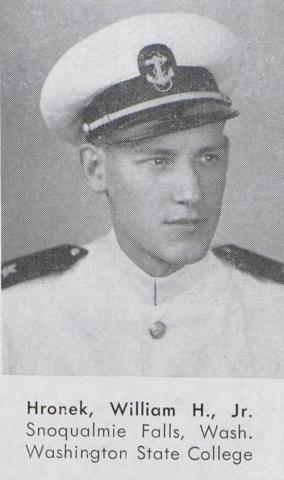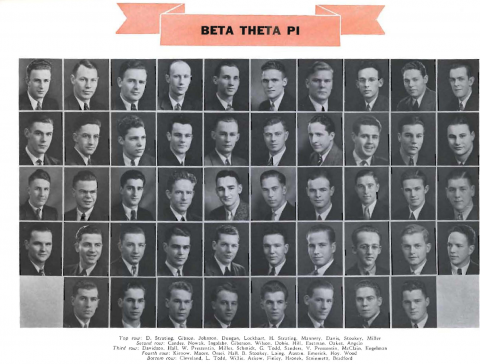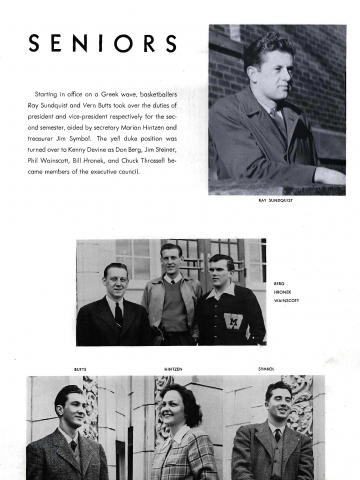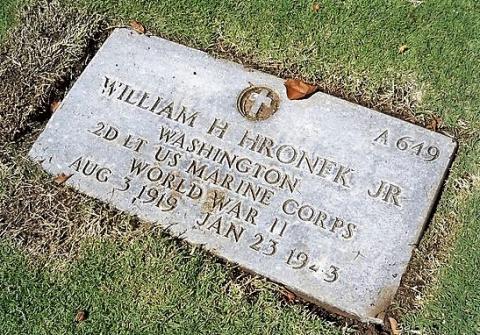William Henry Hronek, Jr.
Pre-WSC Background
William Henry Hronek, Jr. was born to William Henry, Sr. and Laura Sabol Hronek on August 3, 1919 in North Bend, Washington. He was their second child; he had an older sister, Mary, who was born in March 1918. William, Sr. worked as a pay clerk at a lumber mill at the time of his son’s birth. He grew up in the town of Snoqualmie Falls, which lies on the ancestral lands of the Snoqualmie Tribe, a subgroup of the Coast Salish. Snoqualmie is the English pronunciation of the Salish word meaning moon. Euro-American settlers began arriving in the area in the 1850s, and by the 1870s several logging companies operated in the region. By 1889, entrepreneurs sought funds and built the Seattle, Lake Shore, and Eastern railroad into the Snoqualmie Valley, making the timber market a global one.
The same year the railroad was established, the town of Snoqualmie was platted by a civil engineer, Charles Baker. Baker also constructed an underground power plant at the falls in the 1890s, resulting in electricity and jobs for residents. Snoqualmie Falls, the town, soon became a small company town. Snoqualmie voted for incorporation in 1903, and in 1917 the second all-electric lumber mill in the nation, Snoqualmie Falls Lumber Company, opened, giving the town a significant and stable employment base. While the Great Depression hit many in the agricultural and logging industries hard, Hronek, Sr. continued to work at the mill and moved up to the position of Store Manager. Nearby North Bend experienced an influx of jobs in the summer of 1935 with the building of Camp North Bend through the Civilian Conservation Corps (CCC); the camp housed hundreds of workers doing public works projects in the nearby Cascades.
Hronek attended grade school at Snoqualmie Falls, and he joined Boy Scout Troop 492 in 1931. He achieved the rank of Eagle Scout in 1936. According to his parents, he enjoyed outdoor sports such as golf and mountain climbing. He worked during the summers at the company store his father managed, and as a floor salesman in Seattle. He graduated from Snoqualmie High School in 1937. His parents noted he was a Catholic who attended mass regularly.
WSC Experience
Hronek attended Washington State College (WSC) from 1937 to 1941, graduating with a Bachelor of Arts degree in Business Administration in June 1941. Known as “Bill” Hronek, he joined Beta Theta Pi fraternity, an organization celebrating its 100th anniversary on the WSU campus in August 2020. The men of Gamma Delta, a local fraternity, bought a house and some land on Linden Street in Pullman and successfully petitioned to become a chapter of Beta Theta Pi Fraternity on January 17, 1920. The motto of the fraternity is “Men of Principle.” Hronek represented Beta Theta Pi at several dances, including one hosted at Davie Jones’ Locker for Sigma Nu pledges in November 1940. Dance organizers promised the scene to be filled with mermaids and sailors dancing to Ed Hagenau’s music, with a background of mock seaweed and the deep sea. Hronek was also initiated into Alpha Kappa Psi, the men’s professional business fraternity, in 1941.
Outside of academics and fraternity life, Hronek served as a member of the Student Activities Committee, a student organization responsible for giving the “final nod or ‘no’ to proposed social functions.” During his freshman year, he lost his Eastman Kodak f. 6.3 lens, and posted an ad in The Evergreen, offering a reward for its return. He worked for the Washington State Evergreen as part of the news staff. As a sophomore, Hronek was nominated for class president but he lost to classmate Robert Judy. For his final semester during his senior year, he became a member of the executive council for the senior class student government. He also served as chairman for the spring dinner hosted by Business Administration students his senior year. He advised all students to take advantage of the opportunity to attend the dinner so they could “see the profs with ‘their hair down.” Hronek also trained in the Civilian Pilot Training Course at WSC.
The Civilian Pilot Training Program (CPTP) began in the United States in 1938. President Franklin D. Roosevelt supported the CPTP’s plan to train 20,000 pilots a year in order to create a pool of potential military pilots in the event of war. The Army only had a total of 4,502 pilots in 1939; with the implementation of the CPTP program at 1,132 colleges and universities and 1,460 flight schools, student pilots recorded nearly 12 million flying hours, and the program trained 435,165 pilots from 1939 to 1944. Following the attack on Pearl Harbor, the CPTP’s name changed to the War Training Service (WTS). From 1942 through the end of the program in the summer of 1944, trainees still attended college while taking private flight training, with the promise to enter military service following their graduation. As a cadet, Hronek reached the rank of Lieutenant Commander.
Hronek was engaged to Marianne Busch, a WSC speech major, from Oregon City, Oregon. She was named “queen of Washington” in April 1940, and represented the state in the all-American girl contest, competing against queens from forty-seven other states. She was also WSC’s candidate for the crown of queen of the Drake relays. The newspaper announcement proclaiming this news dryly noted that “Oh, yes, the girl chose to represent the state of Washington as queen is from Oregon City, Ore.” Busch also turned in a perfect academic record and made the all-college scholarship roll for the first semester of the 1941 to 1942 school year. She graduated with her Bachelor of Arts degree in Speech in June 1942.
Wartime Service and Death
Hronek registered for the draft on October 16, 1940. Following his graduation from WSC, he joined the United States Marine Corps Reserve (USMCR) at Naval Station Puget Sound at Sand Point in Seattle on September 3, 1941. The Sand Point location served as the Naval Air Reserve training facility until December 7, 1941, and during World War II supported air transport and ship outfitting for the Alaskan and Western Pacific areas of operation. Following his initial training, Hronek reported to the U.S. Naval Air Station, Corpus Christi, Texas in November 1941. He received his commission as a Second Lieutenant, USMCR on May 23, 1942, and became a Naval Aviator on July 3, 1942. The January 19, 1942 issue of The Evergreen was dedicated to former WSC college students stationed at the U.S. Naval Air Station, Corpus Christi, Texas, among them Cadet Bill Hronek.
Hronek visited his family in Snoqualmie Falls for two weeks in July 1942 before leaving for San Diego. Marine Aircraft Wings, Pacific were activated at San Diego on August 15, 1942, with the 1st Marine Aircraft Wing command echelon arriving at Guadalcanal on September 3, 1942. Hronek was assigned to Marine Scout Bombing Squadron 132 (VMSB-132), known as “The Crying Red Asses,” and first traveled to New Caledonia in the South Pacific via the USS Mumu on October 14, 1942, landing at Noumea on October 28. On October 30, 1942, VMSB-132 landed at Henderson Field, Guadalcanal. Upon arrival, they became part of the Cactus Air Force (CAF) and remained fighting on Guadalcanal until December 1942.
The Battle of Guadalcanal began in August 1942 and didn’t end until February 1943. Guadalcanal is one of the southern Solomon Islands in the South Pacific, and the fighting consisted of a series of land and sea battles between Allied and Japanese forces. The hardest fighting occurred on October 24-25, when a single Marine battalion served as the one obstacle between Henderson Field and two Japanese regiments. Commanded by Lieut. Col. Chesty Puller, the 1st Battalion of the 7th Marine Division pushed back the Japanese assault and inflicted heavy casualties on enemy troops. They were reinforced by the first U.S. Army unit to land on Guadalcanal, the 164th Infantry Regiment, helping Puller’s Marines to withstand repeated Japanese charges. Gunnery Sgt. John Basilone, who would later help raise the American flag at Iwo Jima, was awarded the Medal of Honor for “conspicuous gallantry” during the fight.
By November, Allied counterattacks had pushed the Japanese toward the northwest part of Guadalcanal. Up until that point, the CAF had taken out hundreds of Japanese planes. However, on November 13 the Japanese battleships Hiei and Kirishima arrived with the mission to destroy Henderson Field. They were ambushed by American cruisers and destroyers, followed by hits from the CAF fighters. On November 14, a Japanese cruiser force attempted to achieve what the battleships had failed to do, but they instead were attacked by “every available Cactus Air Force plane…” Only 40 percent of the 10,000 Japanese troops landed on Guadalcanal, with limited supplies. This was a turning point in the months-long battle, as the Japanese continued to try and inflict damage on Henderson but they gave up on attempting to recapture it. Second Lieutenant William H. Hronek, Jr. received the Distinguished Flying Cross for his actions as a pilot attached to Marine Scout-Bombing Squadron One Thirty-Two during action against Japanese forces from November 5 to December 24, 1942. His citation reads, in part, as follows:
With courage and determination, Second Lieutenant Hronek participated in a total of thirty-three hazardous missions over hostile territory. When attacked by six Japanese fighters while conducting an aerial search on November 7, he exercised such skillful evasive tactics that he not only enabled his gunner to shoot down one aircraft but also succeeded in eluding the enemy in order to continue his mission. His cool and alert performance of duty under intense fire was in keeping with the highest traditions of the United States Naval Service.
Hronek left Guadalcanal on December 20 to the New Hebrides islands (now the country of Vanuatu) for a period of rest. The New Hebrides offered a strategic location for the Allies during World War II due to their proximity to the Solomon Islands, New Guinea, and Australia. In a surprise move, Americans arrived in May 1942 much to the relief of the local population fearing an imminent Japanese invasion. The Americans built massive infrastructure on the two main islands, Efate and Espiritu Santo, and turned Vanuatu into a large offensive staging area. On the morning of January 23, 1943, just before 6 a.m., Hronek waited on a runway to take an aerologist up for a weather scouting report. Aerologists were used during World War II to provide reports about weather conditions over the Pacific, offering strategically important information used to create plans for air attacks.
According to Glenn Warner, a fellow member of Hronek’s squadron, Hronek “taxied out of the Cocanut Grove onto the runway” just as “another squadron started to take off. As it was still fairly dark neither pilot was able to see the other. The planes met head-on and the end for both pilots was instantaneous.” The aerologist traveling with Hronek received serious injuries but survived the collision.
Postwar Legacy
Hronek’s death deeply affected those who knew him, whether it was in his role as an Eagle Scout, student at WSC, and as an officer and pilot in the USMCR. Warner wrote to Hronek’s mother of their unit’s closeness, stating that she could feel “justly proud of Bill’s record. The courage and determination he displayed will be a constant inspiration and example to those of us who remain…Bill’s courage and daring as a pilot made him feared and respected by enemy and friend. His congeniality on the ground gained him the reputation of being a real pal. When he left us he left a gap in the squadron [that] can’t be easily filled.” David H. McDonald, United States Navy Chaplain, wrote to Mrs. Hronek, letting her know that he knew her son well. He described their last moments together, in part, as follows:
The Thursday noon before, he came to me and asked me to say a Mass for his buddy who was killed that morning. I said the Mass the [next] morning – Friday – Bill went to Confession and Communion. The next day while I was saying Mass, I heard the crash – It was our Divine lord, calling your precious boy to Himself. I went down and said the prayers at his grave. I thank our Divine Lord for giving me the [vocation] to be a Navy Chaplain when I can meet men like Bill Hronek.
I can understand how you [feel] and any words of mine or anybody else, must sound false and shallow but you are the mother of a saintly boy. I don’t pray so much for him as to him, and I know his prayers will help us to accept God’s [Holy] Will.
An article in the Snoqualmie Valley Record on September 17, 1943 paid tribute to Hronek, with an introduction stating there were few homes in the Upper Valley “that have not been saddened this week by the news that Lieut. Wm. Hronek, Jr.,…died as a result of injuries sustained in a plane accident ‘somewhere’ in the South Pacific.” The author described the news as a “great shock to his relatives,” as they’d recently received a letter from Hronek stating his Christmas packages arrived and he was on furlough for rest. He’d assured his family he was “safe and for the folks not to worry.” An earlier letter from Hronek, dated November 25, 1942, advised his family he had “saw to it personally that Bill Borden’s death was avenged,” referring to his old friend, Lieutenant William Borden of the Army Air Corps.
The article concluded by reflecting on Hronek’s popularity with those who knew him, and that he, the “late” Wayne Terhune, and Lieutenant William Borden were all Eagle Scout members of Troop 492, Snoqualmie Falls, and had attended all twelve years of their primary and secondary education together. The author noted how difficult it was “for one who has known and admired the many sterling qualities of this fine young man, to write an article covering his life and dealing with his untimely death.” Hronek’s father wrote to WSC President Emeritus Holland that his son “did so much enjoy and did take pride in that he was a student of the W.S.C. and finished his course before entering the service…deep in our hearts there will always be a feeling that W.S.C. was the final instrument that made him the sterling character he proved to be – he made the supreme sacrifice that others might enjoy what our great country stands for.”
Hronek is interred at the National Memorial Cemetery of the Pacific (Punchbowl) in Honolulu, Hawaii. He is memorialized on the WSU Veterans Memorial as well as the Snoqualmie Valley Veterans’ Memorial. His fiancée, Marianne Busch, married Timothy Leary, American psychologist, author, leading advocate for the use of LSD and other psychoactive drugs, and author of the 1960s counterculture slogan, “turn on, tune in, drop out.” Sadly, she committed suicide in 1955, leaving behind her husband and two young children.




